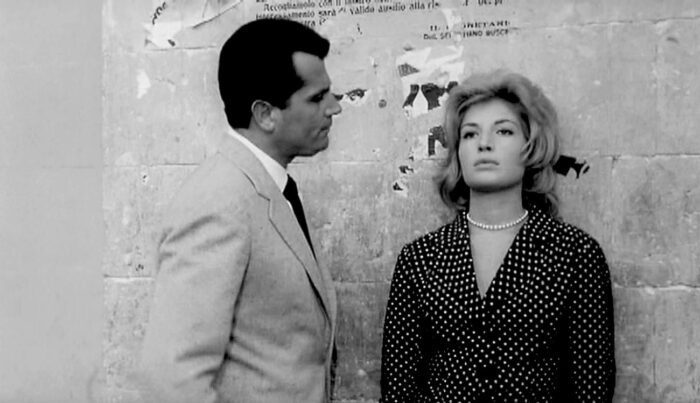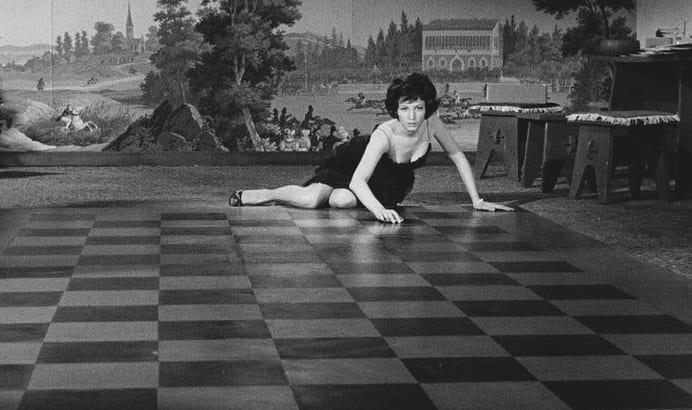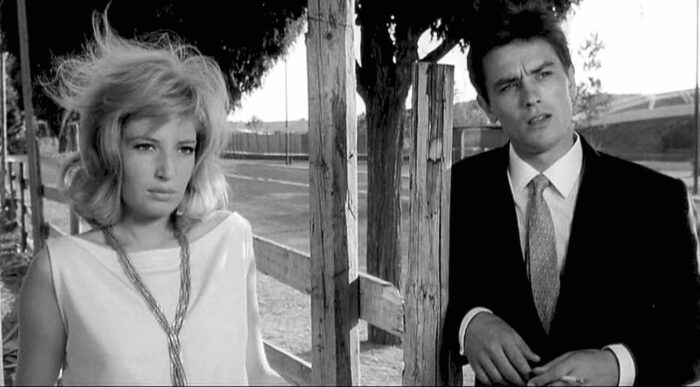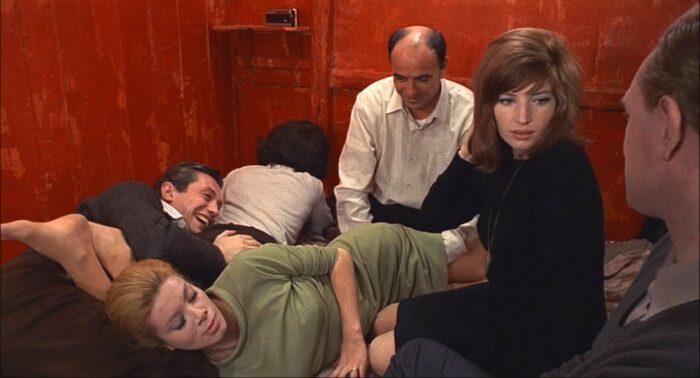Actress Monica Vitti first met film director Michelangelo Antonioni in 1957 where he cast her for a role in his film Il Grido. Three years later she was the star of his next film, the acclaimed L’Avventura (1960). Over the next two years, Vitti became involved with the director and his next three film projects either featured her in leading roles or in memorable supporting ones. Two of these films, La Notte (1961) and L’Eclisse (1962), form Antonioni’s alienation trilogy (along with L’Avventura), while Red Desert (1964) is regarded as an outside entry (although certain themes remain). During the filming of Red Desert, Vitti and that film’s cinematographer Carlo Di Palma began a romantic relationship which lasted longer than her courtship with Antonioni.
After Red Desert, Vitti starred in lighter projects which showed her comedic side. First in the camp, James Bond spoof Modesty Blaise (1966) and in the ’70s, Vitti played a key part in Luis Buñuel’s The Phantom of Liberty. The following year she starred in Di Palma’s comedic road movie Blonde in Black Leather (1975) co-starring another female icon of Italian cinema, Claudia Cardinale. Di Palma went on to an illustrious career working as Woody Allen’s cinematographer throughout the ’80s and ’90s while Vitti retired from acting in 1992. However, her contribution to cinema is far from forgotten and here we look at at her performances in the four films which have defined her legacy.
L’Avventura (1960)

L’Avventura begins with a young woman walking along a path in a wide field where we notice construction going on in the distance. The woman meets up with her father where the two exchange some words. We learn the woman and her father have never had the closest relationship and that the man she’s engaged to be married may not be in it for the long haul. With that, the woman bids her father goodbye. The woman is Anna (Lea Massari) and then joins best friend Claudia (Vitti) who waits down on the road while Anna and her boyfriend Sandro (Gabriele Ferzetti) make love up in his apartment. If you have never seen L’Avventura you’d assume the movie is about Anna and Sandra and their story will become the film’s dramatic narrative. If you have seen L’Avventura then you know Anna disappears 27 minutes into the movie without a trace, not to be seen again, and Claudia becomes the principal character for the rest of the story. Perhaps this was why audiences derided and booed the film during its first screening at Cannes in 1960.
Vitti, who was close to Antonioni, was hurt and confused by this initial reaction, especially as someone who had put so much into her performance. Words such as “distant” have often been used to describe the characters in Antonioni’s films and if you only knew of this reputation before watching Vitti in this film you’d wonder who came up with such a word. During the opening 20 minutes the audience watches Claudia frolicking from end of a boat to the other laughing freely, her wild hair blowing in her face as she kicks her legs about. It’s not behavior we’d expect from someone “distant.” As the film goes on, we see less and less of this happier Claudia. As the mystery of Anna deepens we soon see her near the brink of emotional collapse only to regain her sense of self (as much as she can fake it).
Yes, Claudia becomes involved with Sandro after Anna’s disappearance but even that goes so far. If viewers were expecting her to fall into her male companion for emotional reassurance, it happens the other way around. Claudia’s inner strength grows as little by little we observe Sandro’s fall. An encounter with a younger art student towards the film’s end display Sandro’s insecurities yet Claudia, much like Antonioni does things her own way. In the end, it is she that possesses the strength Sandro longs for.
Vitti shines as Claudia, someone who we meet as being free-willed and happy, but with Anna’s absence weighing on her we learn she’s the most tormented character in this film. She carries guilt for laughing at Anna’s seductive, impulsive ways instead of being more concerned about where it may lead her. She’s detached from the world of evening parties in large elegant houses and only feels true happiness from Sandro’s affections—up to a point.
The initial screening of L’Avventura did not go well—in fact, it was jeered and booed by the audience. Yet the next day, a crestfallen director and actress received a different reaction. The rest is, as they say, history.
La Notte (1961)

In La Notte, Monica Vitti doesn’t even appear until near the one-hour mark and even then she says nothing until her second on-screen scene. In La Notte, the film’s main couple, Giovanni and Lidia Pontecova (Marcello Mastroianni and Jeanne Moreau) attend a glitzy gathering at a Milan estate where long tables of food are laid out across the grass and the upper crust of society are gathered together, yet nothing of any real meaning is discussed among the varied guests. For enjoyment, there doesn’t seem to be a lot of that happening at the function as well.
That is until Giovanni comes across Valentine Gherardini (Vitti) the daughter of the event’s host. Valentina is sprawled on the floor all alone in a spacious room who feels more comfortable here than she does, mingling among the well-dressed party-goers. This is the only time in Antonioni’s trilogy where the actress dons a dark hairstyle, giving her an edge that she didn’t exhibit in the other movies on this list. Valentine’s simple impromptu game of sliding her compact along a large checker floor pattern draws a large crowd (male who cheer and whoop at every move she makes). By the time her game is over she’s played another one and this time it involves the Gherardini’s.
Valentina leaves her compact behind and plays a little with Giovanni who makes a serious pass at her while Lidia looks on from a floor above. Soon she finds her own strange companion in Roberto (Giorgio Negro) who asks Lidia to join him alone in his car as a sudden rain forces everyone inside the palatial estate. Giovanni continues his pursuit of Valentina who instructs him to return to his wife before events progress further. When Lidia returns, Valentina offers her a towel and a chance to talk. Of course Giovanni’s name is mentioned and when the woman’s part ways, the couple are left with a realization they are not and have not been happy for some time. In her role here, Vitti shows cunning intelligence that’s not so apparent in the other Antonioni’ films she’s appeared in. Although her screen time is brief, her impact is so much so, Stanley Kubrick has called this film one of his ten favorite movies of all time.
L’Ecclise (1962)

In the third film of Antonioni’s trilogy, L’Ecclise, Vitti once again takes center stage as this film’s main character (until she disappears for a stretch but more on this development later) . In L’Ecclise, Vitti portrays a woman named Vittoria (no last name given) who in appearance and demeanor could be taken for L’Avventura‘s Claudia. One almost wishes Antonioni did transport the same character into this story however the director created a new character for his muse in this, their final black and white collaboration together.
As L’Ecclise opens, we see it is morning and Vittoria, dressed in a sharp black evening dress, has been up all night. We learn she’s been quarreling with her romantic partner, Riccardo (Francisco Rabal) until dawn and the two are breaking up. As Vittoria leaves Riccardo she strolls along the empty streets of Rome and exhibits a freedom we’ve not seen in her demeanor until now. As the day progresses and with Riccardo behind her, Vittoria visits her mother (Lilla Brignone) who works at the Rome Stock Exchange yet the mother is more concerned over the activity on the floor than in her daughter’s personal life.
Vittoria is introduced to Piero (Alain Delon), an energetic stockbroker who over time takes an interest in her, more so than her own mother does. Around the 50-minute mark Antonioni does an interesting thing with this narrative—he diverts from the Vittoria storyline and spends a good 15-20 minutes of screen-time devoted to Piero and his work. At first viewing, a viewer might sense something odd happening as the minutes go by. First two, then five, then ten with no sign of Vitti’s character. Those familiar with L’Avventura might wonder if she has received a similar fate as Anna from the earlier film.
‘Is Vittoria gone for good’, ‘what happened to her?’
Just when we believe that character’s story is over, she appears once more without explanation. Now 15 minutes isn’t a lot in a person’s actual life but in film time it’s an eternity. What is remarkable about L’Ecclise is the way characters are introduced, made absent and then appear again. We started with Vittoria and Riccardo, then Vittoria, then Piero, and then for the rest of the film, it’s Vittoria and Piero.
Finally, after three movies, Vitti is given the chance to exhibit playfulness and showcase her romantic giddiness. There’s a warmness on display in the final third of this movie which wasn’t showcased in the previous two. It’s apparent the two actors very much enjoy their scenes together and out of the three movies, when the end arrives, this is the relationship which viewers could believe as one with a future. But this is Antonioni we’re talking about and romantic happy endings are not in his wheelhouse. As suddenly as the two appear on screen, they disappear just as fast and the final seven minutes of this film doesn’t feature either of them. Antonioni devotes the last minutes of these seven hours of screen time (if you place the movies together) to various locations and buildings in Rome. Shots we have seen before where the two leads have been alone or together are now absent of the two. Instead we observe empty roads, structures, strangers, street lights and so forth become the main focal point. We see neither character again. And this ends Antonioni’s black and white series of films with his leading actress Monica Vitti. In true typical Antonioni fashion, Vittoria did vanish into nowhere just as Anna had in the first feature. 60 years later audiences are wondering what happened to both women and It’s safe to assume 60 years from now, they’ll still be wondering.
Red Desert (1964)

Red Desert marks the most radical departure from the previous three Vitti/Antonioni films in that it’s the first color film the director had ever made, yet an artist known for such striking images set his movie amidst an environment comprising fog, drizzle, and rust. Antonioni is once again defying expectations as even his title Red Desert evokes images of sandy terrain and bright sunny skies. If you’re looking for that Red Desert is sure to disappoint. Red is quite sparse here (except for one memorable sequence which takes place in a tiny shack with faded painted red walls) and Vitti’s glorious shock of hair.
Right away we notice the actress is playing a very different character than in her previous collaborations with the director. Along with her red hair, a small child accompanies her whereas she’d been childless in three preceding films. Even though she’s dressed rather stylishly this time, we sense a physical weakness. She struggles to tread along the muddy ground—a stark contrast to the commanding way she would almost glide down the polished clean streets and fancy hallways of Milan and Rome. Even Antonioni frames her so the environment overwhelms her. She’s often filmed under oppressive bleak skies and this time her close-ups were kept to a minimum.
We learn her name is Giuliana (again no last name) and that she’s married to an industrial manager named Ugo (Carlo Chionetti). Through Ugo we learn she was in an auto accident and has not been herself ever since. Giuliana takes interest in Corrado (Richard Harris) who she confides in. At one point all three meet up with another couple and in the film’s centerpieces aloud confessions of sexual attraction and scenarios. Giuliana’s mental state becomes fraught throughout the story and for the first time, the director almost veers into horror territory with his shots.
Vitti is unglamorous in this role. Besides her darker hair which she hides her expression, we often see her in bulky coats to not only protect her from the weather but from the harshness of reality. Towards the movie’s conclusion, in her alone scenes with Corrado, she dons a more sophisticated, stylish look in a dressy coat and leather gloves, yet this is a temporary glimpse into who the real Giuliana is (the one we saw in the red shack sequence). Soon her mental state deteriorates again, leaving her paranoid, alone, confused and frightened.
Perhaps it was the emotional toll this character took on the actress, but after Red Desert, Vitti and Antonioni would not work again until the early ’80s. Vitti fell in love with this film’s cinematography and took on a series of more comedic yet defined, sexy, confident roles. Still, these other films loved the physical Monica Vitti—it was Antonioni who loved the deeper aspects of the actress. When one thinks of L’Avventura, La Notte, L’Ecclise, and Red Desert it isn’t the rocky cliffs of Sicily, the long hallways of mansions in Rome or the bustling streets of Milan, it is the face of these movies’ lead actress, Monica Vitti.
A face mysterious, arresting, arousing, curious and unforgettable.


